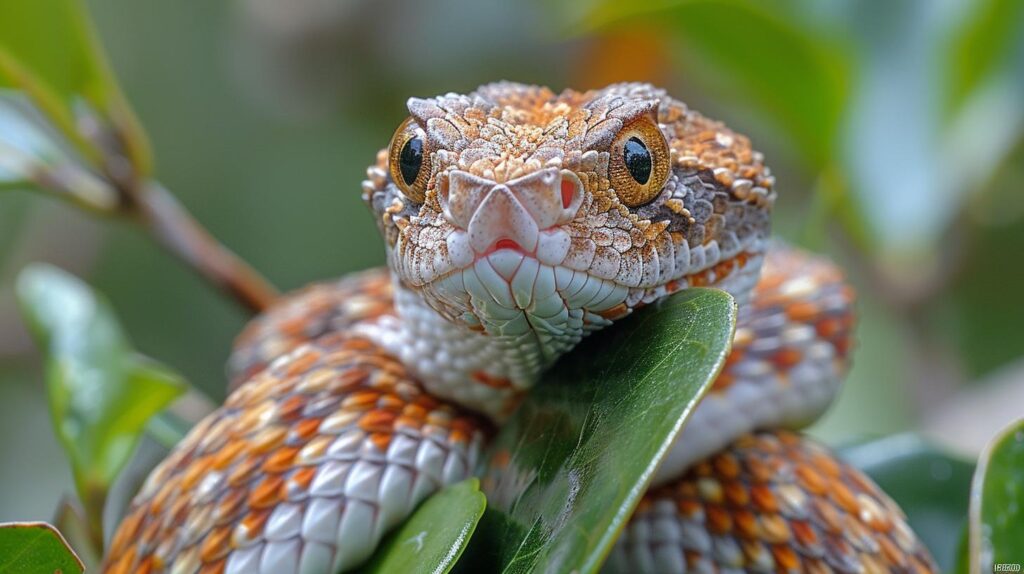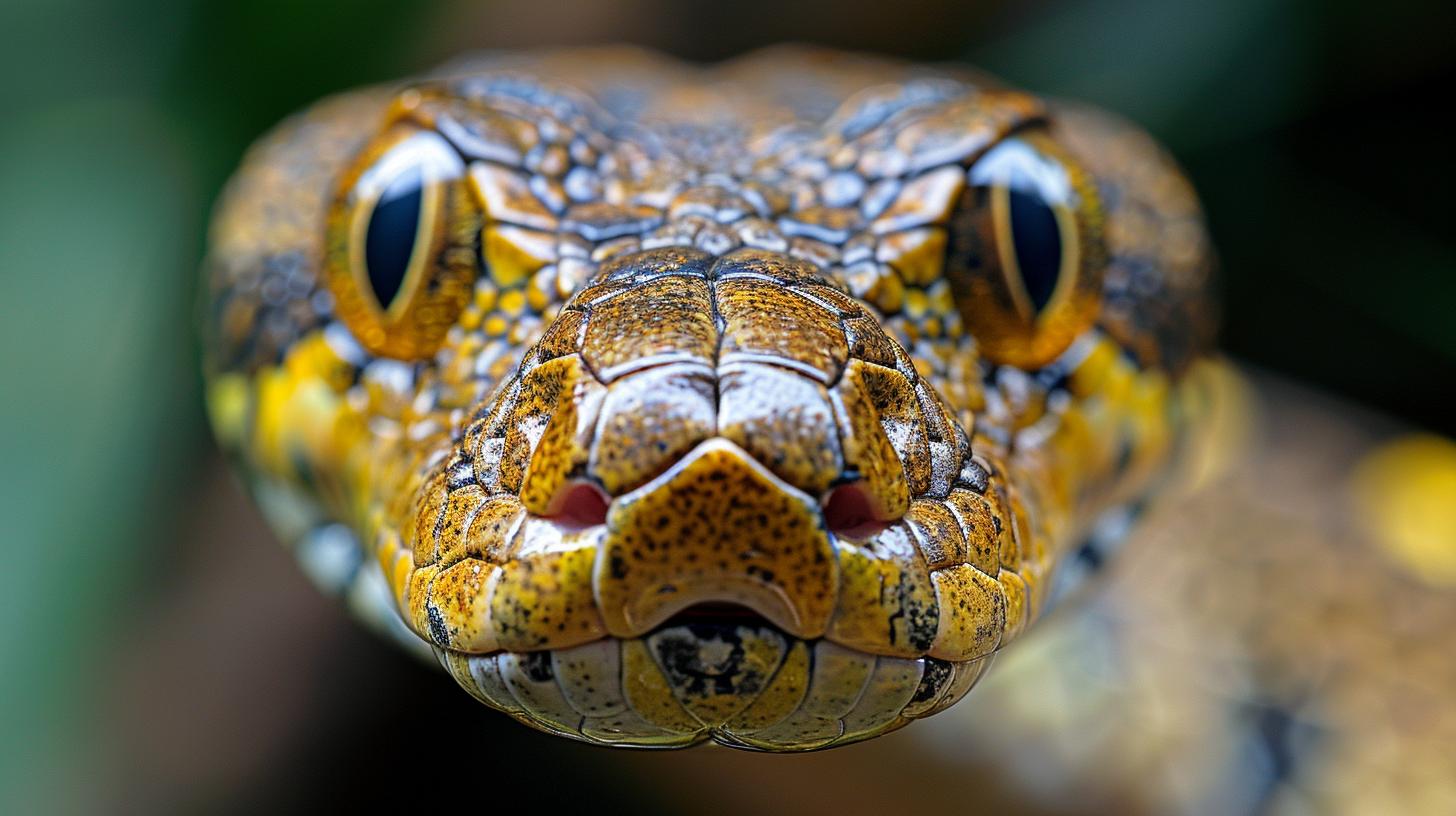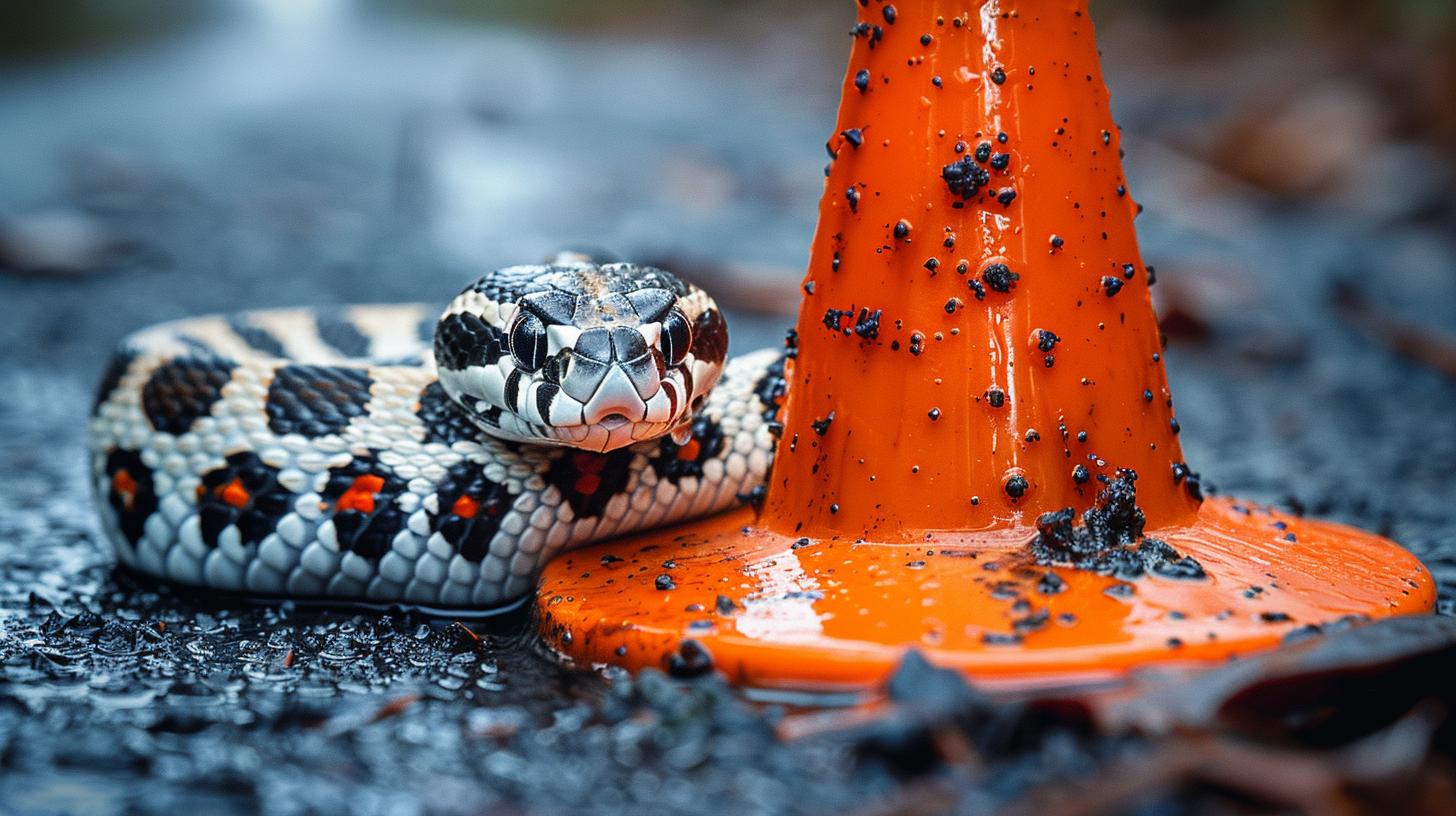Is Your Snake Stressed? Uncover the Warning Signs

Understanding Snake Stress
Noticing the snake stress warning signs early can make a significant difference in ensuring your pet's health and happiness. Stress in snakes, often overlooked, plays a crucial role in their wellbeing. This article embarks on a journey to demystify stress in these slithering pets, stressing why it's vital for owners and snake enthusiasts alike to stay vigilant.
Understanding the nuances of snake behavior isn't straightforward; recognizing when your serpentine friend is under pressure is even more challenging. Stress doesn't just affect their mood-it can have far-reaching implications on their health. As we delve into this topic, we aim to illuminate the subtle cues that may indicate your snake is experiencing stress. It's these insights that will equip owners with the ability to act swiftly, ensuring their pets remain in good spirits.
The initial step towards mitigating stress lies in identifying its early manifestations. Changes in behavior or physical appearance, though subtle, are telltale signs that shouldn't be ignored. As we progress, detailed exploration of specific behaviors and symptoms will paint a clearer picture of what stressed states look like in snakes. Drawing attention to these markers will empower owners with the knowledge necessary for quick recognition and response.
Addressing snake stress warning signs not only involves detecting them but also understanding their root causes. The factors inducing stress range widely-from environmental shifts to underlying health issues-painting a complex picture of snake psychology and physiology that deserves careful consideration. This comprehensive approach aims at not merely spotting stress but preventing it through informed care practices, ultimately fostering an environment where snakes can thrive free from undue pressure.
Early Signs of Stress in Snakes
Recognizing the early signs of stress in snakes is crucial for their health and well-being. Like many other pets, snakes exhibit certain behaviors and physical cues that can indicate they're feeling stressed. However, these signs can often be subtle and overlooked by even the most attentive snake owners.
Understanding what to look for is the first step in addressing and alleviating the stressors affecting your snake. This awareness enables timely intervention, preventing the escalation of stress into more severe health issues. Guiding snake enthusiasts through this knowledge not only enriches their care practices but also deepens the bond between them and their serpentine companions.
To effectively monitor the wellness of a pet snake, owners must familiarize themselves with its baseline behavior and appearance. Any deviation from this norm might suggest that something is amiss. Since stress reactions can vary significantly among different species of snakes, recognizing these changes requires careful attention and a good understanding of your specific pet's habits and preferences.
Behavioral Changes as Warning Signals
One of the most noticeable snake stress warning signs comes through behavioral changes. These alterations could manifest as an increased skittishness or aggression towards handling when they were previously docile or indifferent to human interaction. Conversely, a typically active snake becoming lethargic or refusing to eat can also be indicative of stress.
Such shifts are telling signs that the snake is not in its optimal state of comfort. Observing these behavioral patterns requires a baseline knowledge of what's normal for your snake, emphasizing once again the importance of familiarity with your reptilian friend's typical demeanor.
Physical Symptoms to Watch For
In addition to behavioral cues, physical symptoms can also provide insights into a snake's stress levels. Unexplained weight loss, despite regular feeding, could signal chronic stress or underlying health issues needing attention. Similarly, frequent attempts to escape by pushing against enclosure limits might indicate an unsatisfactory habitat environment contributing to your snake's distress.
Another aspect to note is your snake's skin condition; consistent problems with shedding (dysecdysis) are often related to prolonged stress periods affecting their physiological functions.
The capability to identify early signs of Snake Stress Warning Signs lies at the heart of responsible snake care. It paves the way for interventions tailored towards minimizing potential triggers within their living environment or consulting veterinary professionals for further guidance if needed. By staying attentive to these signals-both behavioral and physical-owners can ensure a healthier life for their serpent companions amidst an increasingly stressful world.
Snake Stress Warning Signs
Understanding the signals that indicate your snake is under stress is imperative for their health and happiness. Snakes, unlike many pets, are not always vocal about their discomfort. This makes recognizing the non-verbal cues of snake stress warning signs critical to providing timely care and preventing long-term health issues. Owners need to be vigilant and educated on what these indicators look like in practice, given that prolonged stress can have severe implications for a snake's well-being.
Behavioral Changes as Warning Signals
One of the most telling signs of a stressed snake is a noticeable shift in their behavior. Snakes that were once docile and comfortable being handled may suddenly become aggressive or try to flee every time you approach them. This unexpected change is often one of the early signs of stress in snakes.
Additionally, if your snake starts refusing food or has a disrupted shedding process, it's imperative to consider these as potential alarm bells for stress. These behavioral modifications serve as immediate red flags that something within their environment or health status isn't right, necessitating a closer look by the owner.
Physical Symptoms Indicating Stress
Beyond behavioral shifts, physical symptoms also play a crucial role in identifying stressed snakes. A common yet often overlooked indicator is an irregular posture, such as coiling tightly or excessively hiding, which suggests discomfort or fear. Moreover, frequent attempts to escape can lead to nose rubbing against enclosure walls leading to visible damage - another glaring sign of distress. Observing these physical changes requires attention to detail and regular interaction with your pet snake to spot discrepancies early on.

Identifying snake stress warning signs involves paying close attention both to changes in behavior and physical health indicators. Recognizing these signs promptly can be pivotal in addressing the root causes before they escalate into more severe health problems. As such, understanding how stress manifests in snakes is key for any responsible snake owner looking to ensure their pet enjoys a peaceful and healthy life free from undue tension and anxiety.
Common Causes of Stress in Snakes
Understanding the common causes of snake stress warning signs is essential for any snake owner. Various factors can contribute to a snake feeling stressed, ranging from environmental conditions to improper handling. By identifying these triggers, owners can take proactive measures to create a comfortable and stress-free environment for their snakes.
Firstly, inadequate habitat conditions stand out as a primary stressor for snakes. This encompasses several aspects:
- Incorrect temperature or humidity levels: Snakes are ectothermic creatures that rely on their environment to regulate body temperature. An unsuitable thermal gradient or humidity can lead to discomfort and stress.
- Lack of proper hiding places: Snakes need secure hiding spots to feel safe and manage their stress levels. A habitat lacking these areas exposes snakes to constant visible stressors.
- Overcrowding: Placing too many snakes in a confined space can result in increased competition for resources and elevated stress levels.
Another significant cause of stress in snakes is *improper handling*. Snakes vary in how much interaction they tolerate from humans. Frequent or clumsy handling can make them feel threatened, leading to symptoms of distress. It's crucial for handlers to understand the tolerance levels of their snake species and adjust their interaction accordingly.
Lastly, changes in the environment or routine can be unsettling for snakes, making adaptability a challenge. Such changes might include moving to a new enclosure, alterations inside their current habitat, or variations in feeding schedules. Each snake reacts differently; some may handle change with ease, while others exhibit clear *snake stress warning signs* such as hissing, striking, or refusing food.
By pinpointing various *causes of stress*, snake owners can adapt their care practices effectively to minimize anxiety-inducing situations for their pets. This involves regular monitoring for signs such as avoiding food, frequent hiding than usual, aggression when handled, or physiological symptoms like weight loss or abnormal shedding - all indicate necessity immediate attention and possible adjustments in the care routine.
In summary, acknowledging and addressing these key factors plays an integral role in preventing stress for captive snakes. Creating an optimal environment tailored to a snake's specific needs not only alleviates potential stresses but also reinforces the animal's health and quality of life. Continuing into understanding management methods will further aid enthusiasts in ensuring their slithery companions lead contented lives free from undue distress.
Managing and Reducing Stress in Snakes
The key to managing and reducing stress in snakes lies in understanding their needs and closely observing changes in their behavior or physical appearance. One of the first steps towards alleviating stress is identifying the sources that contribute to it, such as environmental inadequacies, improper handling, or health issues. After pinpointing potential stressors, snake owners can implement targeted strategies to create a more conducive living environment for their pets.
Adjusting the habitat plays a crucial role in reducing snake stress. This includes ensuring the enclosure is of appropriate size, offers ample hiding spots, and maintains optimal temperature and humidity levels tailored to the species' natural habitat. Regular cleaning and minimal disturbance also contribute significantly to creating a serene environment for your snake.
Moreover, dietary adjustments can impact stress levels; thus, providing a balanced diet suitable for your snake's species is paramount. Feeding routines that mimic wild feeding patterns could also help minimize stress associated with feeding in captivity.
In addition to environmental and dietary changes, proper handling techniques are vital for promoting a sense of security among pet snakes. Gradual acclimatization to human touch and minimizing unpredictable interactions can reduce fear-related stress. Furthermore, establishing routine health checks with a veterinarian experienced in exotic pets can prevent or identify health issues early on before they escalate into more significant sources of stress.
| Strategy | Action Steps |
|---|---|
| Habitat Adjustment | Optimize enclosure size, temperature, humidity, and provide hiding spots. |
| Dietary Management | Offer species-specific balanced diet; mimic natural feeding patterns. |
| Handling Techniques | Gradually acclimatize to handling; minimize unpredictable interactions. |
By combining these strategies-habitat adjustment, dietary management, careful handling practices-and regular veterinary care, snake owners can significantly mitigate factors contributing to snake stress warning signs. It's not only about reacting to the symptoms but also proactively shaping an environment that supports their overall well-being.
Recognition of stress signals enables timely intervention but preventing their onset by cultivating a stable environment offers long-term benefits for both snakes and owners alike. However, should signs persist despite these efforts, consulting with an exotic pet veterinarian becomes imperative to rule out underlying health issues or explore further environmental enhancements needed for effective stress management.
The Impact of Prolonged Stress on Snake Health
Recognizing and addressing the snake stress warning signs is not just about immediate problem-solving; it's fundamentally linked to preventing long-term health issues that can detract significantly from their quality of life. Prolonged stress in snakes can lead to a series of both behavioral and physiological changes, which, if left unchecked, may result in severe consequences. The relationship between chronic stress and its impact on snake health cannot be underestimated.

Firstly, chronic stress can suppress the immune system in snakes, making them more susceptible to infections and diseases. This diminished immune response is particularly concerning because it opens the door to a range of potential health problems, from respiratory infections - often characterized by symptoms like wheezing or mucus buildup around the nostrils - to more systemic illnesses that can be challenging to treat.
Additionally, stressed snakes may exhibit a decrease in appetite or refuse food altogether, leading to weight loss and nutritional deficiencies that further weaken their immune system.
- Behavioral Changes: Long periods of stress might cause snakes to exhibit unusual behaviors such as increased aggression or avoidance, where they frequently hide or flee when approached.
- Physical Signs: Chronic stress manifests physically through signs such as consistent shedding problems, significant weight loss, or unusual fecal matter.
These indicators highlight the necessity for snake owners to remain vigilant about their pets' behavior and physical state. However, acknowledging these signs is only part of the equation; understanding what they signify and how they intertwine with overall health underscores the critical nature of early intervention.
Lastly, it's essential to recognize that while dealing with the immediate effects of stress is vital, focusing on preventive measures plays an equally important role in safeguarding your snake's well-being. Regular monitoring for any changes that deviate from normal behavior or appearance should prompt further investigation into possible causes of distress.
Coupled with a deep understanding of environmental factors that contribute to stress will enable owners and caretakers to create a nurturing habitat for their snakes-a crucial step towards mitigating the harmful effects prolonged stress has on these fascinating creatures' health. By doing so, we pave the way for future discussions on advanced care strategies aimed at fostering resilience against stress among pet snakes.
Supporting Your Snake's Overall Well-Being
In wrapping up our discussion on the intricate subject of snake stress and its impacts, we've traversed from understanding what constitutes stress in these unique reptiles to spotting the critical snake stress warning signs. Along this enlightening journey, it's clear that the well-being of snakes hinges significantly on our ability to perceive and react to their distress signals promptly.
The knowledge shared across these sections empowers snake owners with invaluable insights, enabling them to create a nurturing environment that counters stress factors effectively and ensures their slithery companions lead long, healthy lives.
Addressing the root causes of stress in snakes requires a comprehensive approach, one that encompasses everything from optimizing their living conditions to ensuring they're receiving adequate care tailored to their specific needs. Whether it's by fine-tuning their habitat to mimic their natural environment as closely as possible or by adopting gentler handling practices, each measure plays a pivotal role in mitigating stress.
By fostering an in-depth understanding of what makes these fascinating creatures thrive, owners can preempt potential health issues and pave the way for a harmonious coexistence that enriches both their lives and those of their pet snakes.
As we conclude this insightful exploration into snake stress and its ramifications, let us extend an invitation for you to continue fuelling your curiosity and passion for reptile care through our extensive collection of articles. Our commitment is to provide you with a wealth of knowledge that not only enhances your expertise but also strengthens the bond between you and your reptilian companions.
So dive into our content library today-your next read could revolutionize the way you interact with your beloved pet snake.
Frequently Asked Questions
How Do You Know if a Snake Is Stressed?
A stressed snake often exhibits changes in behavior or physical appearance. Signs of stress can include frequent hiding, refusal to eat, hissing or striking without provocation, and significant changes in skin color or texture. Observing your snake's typical behavior patterns is key to identifying any deviations that may indicate stress.
How Do You Calm a Stressed Snake?
Calming a stressed snake involves creating a peaceful and secure environment. This includes minimizing loud noises or sudden movements around the snake's habitat, ensuring the enclosure has adequate hiding spots, maintaining proper temperature and humidity levels, and handling the snake gently and infrequently to avoid overstimulation. Patience and gradual acclimatization to human interaction can also help ease stress.
Do Snakes Shed When Stressed?
Yes, snakes can shed more frequently when they are stressed. Stressful conditions might trigger an increased shedding cycle as a physiological response to cope with the adverse conditions. However, abnormal shedding can also be a sign of other health issues, so it's important to monitor your snake closely and consult with a veterinarian if you notice irregular shedding patterns.
How Can I Tell if My Snake Is Hurt?
Identifying injury in snakes can be challenging since they often conceal their pain. Common indicators of injury include noticeable cuts or bruises on their skin, difficulty moving or an unusual gait, swelling in any part of the body, reluctance to eat, or excessive hiding. Visible signs combined with behavioral changes could point toward an injury that requires veterinary attention.
How Do Snakes Show Sadness?
Snakes primarily express distress through behavioral changes rather than emotions like sadness as humans perceive them. Indications that might suggest a snake feeling 'sad' - more accurately signaling discomfort or stress - include low activity levels, reduced interest in food, increased aggression or defensiveness when approached, and persistent escape attempts indicating unhappiness with its current environment.
How Do Snakes Express Sadness?
Snakes do not express sadness in the same way humans or even other animals do because they lack the facial expressions and complex emotional responses associated with such feelings.
Instead, what might be interpreted as expressions of 'sadness' are actually signs of stress or discomfort manifested through changed behaviors such as lethargy, loss of appetite, aggression, and excessive hiding within their enclosures.
Leave a Reply
You must be logged in to post a comment.